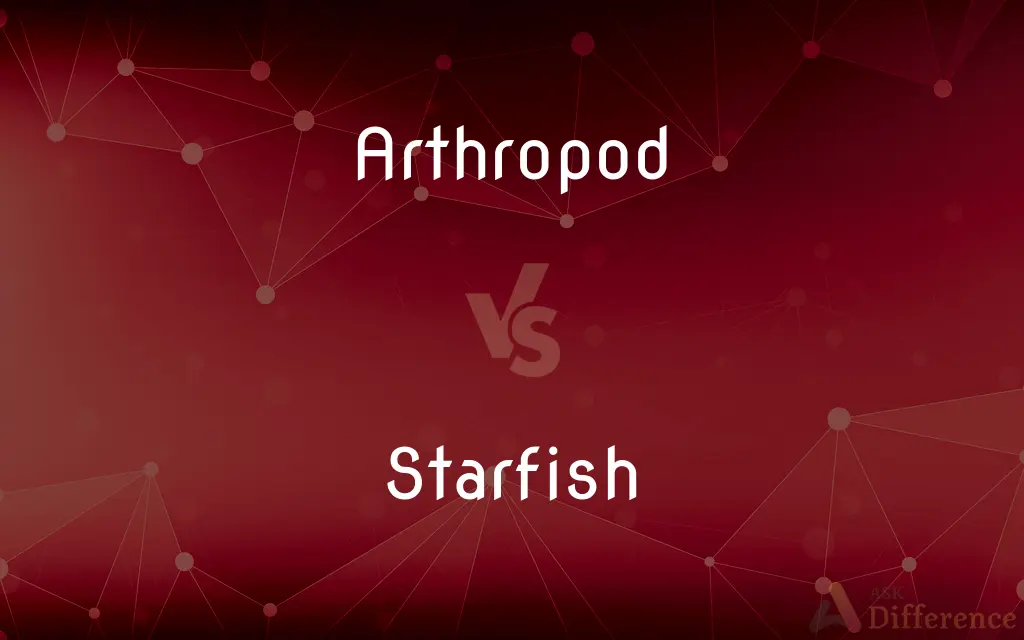Arthropod vs. Starfish — What's the Difference?
By Urooj Arif & Fiza Rafique — Updated on April 5, 2024
Arthropods are a diverse phylum including insects and crustaceans; starfish are echinoderms, not arthropods.

Difference Between Arthropod and Starfish
Table of Contents
ADVERTISEMENT
Key Differences
Arthropods constitute the largest phylum in the animal kingdom, encompassing insects, arachnids (such as spiders), myriapods (like centipedes), and crustaceans (including crabs and lobsters). They are characterized by their segmented bodies, exoskeleton made of chitin, and jointed limbs. Whereas, starfish, or sea stars, belong to the phylum Echinodermata and are known for their radial symmetry, typically with five or more arms extending from a central disk.
The primary habitat for most arthropods is terrestrial, with many species adapted to life on land, although several, especially crustaceans, are aquatic. On the other hand, starfish are exclusively marine animals, residing in a variety of ocean habitats from tidal pools to deep-sea environments.
In terms of locomotion, arthropods move by means of their jointed appendages, which are highly varied and adapted to their environment, whether walking, flying, or swimming. Starfish, however, move using hundreds of tube feet located on their undersides, which operate through a unique hydraulic system.
While arthropods have a centralized nervous system, starfish possess a decentralized nerve net and lack a brain, coordinating movement and feeding through this simpler nervous arrangement. This reflects their differing evolutionary paths and adaptations to their respective environments.
Comparison Chart
Phylum
Arthropoda
Echinodermata
ADVERTISEMENT
Body Structure
Segmented body, exoskeleton, jointed appendages
Radial symmetry, typically five arms, calcareous skeleton
Habitat
Primarily terrestrial, some aquatic
Exclusively marine
Locomotion
Walking, flying, or swimming using appendages
Moving with tube feet via a hydraulic system
Nervous System
Centralized, with a brain
Decentralized nerve net, no brain
Examples
Insects, spiders, crustaceans
Sea stars
Compare with Definitions
Arthropod
Insects, such as bees and ants, are examples of arthropods.
Ants showcase the arthropod's complex social structure.
Starfish
A marine echinoderm with a star-shaped body and radial symmetry.
The starfish clung to the rock, moving its arms slowly.
Arthropod
A member of the phylum Arthropoda, characterized by an exoskeleton and jointed limbs.
The butterfly, a type of arthropod, emerged from its cocoon.
Starfish
Reside in diverse marine environments, from shallow to deep sea.
Divers found starfish in the coral reefs and deep-sea trenches.
Arthropod
Myriapods, including centipedes, belong to the arthropod phylum.
Centipedes, with their numerous legs, are fast-moving arthropods.
Starfish
Known for their ability to regenerate lost limbs.
After losing an arm, the starfish began the process of regeneration.
Arthropod
Arthropods also include crustaceans like lobsters and crabs.
Lobsters, marine arthropods, are popular in gourmet cooking.
Starfish
Starfish have a unique feeding mechanism, often extruding their stomachs.
The starfish feeds by enveloping its prey with its stomach.
Arthropod
Arachnids, another arthropod group, include spiders and scorpions.
The tarantula is a large, hairy arachnid.
Starfish
Starfish or sea stars are star-shaped echinoderms belonging to the class Asteroidea. Common usage frequently finds these names being also applied to ophiuroids, which are correctly referred to as brittle stars or basket stars.
Arthropod
Arthropods (, from Ancient Greek ἄρθρον (arthron) 'joint', and πούς (pous) 'foot' (gen. ποδός)) are invertebrate animals having an exoskeleton, a segmented body, and paired jointed appendages.
Starfish
A marine echinoderm (invertebrate) with five or more radiating arms. The undersides of the arms bear tube feet for locomotion and, in predatory species, for opening the shells of molluscs.
Arthropod
An invertebrate animal of the large phylum Arthropoda, such as an insect, spider, or crustacean.
Starfish
Any of various marine echinoderms of the class Asteroidea, characteristically having a thick, often spiny body with five arms extending from a central disk. Also called asteroid, sea star.
Arthropod
Any of numerous invertebrate animals of the phylum Arthropoda, including the insects, crustaceans, arachnids, and myriapods, that are characterized by a chitinous exoskeleton, a segmented body, and jointed appendages.
Starfish
Any of various asteroids or other echinoderms (not in fact fish) with usually five arms, many of which eat bivalves or corals by everting their stomach.
Arthropod
An invertebrate animal of the phylum Arthropoda, characterized by a chitinous exoskeleton and multiple jointed appendages.
Starfish
(obsolete) Any many-armed or tentacled sea invertebrate, whether cnidarian, echinoderm, or cephalopod.
Arthropod
One of the Arthropoda.
Starfish
The anus. Category:en:Pornography
Chocolate starfish
Arthropod
Invertebrate having jointed limbs and a segmented body with an exoskeleton made of chitin
Starfish
(intransitive) To assume a splayed-out shape, like that of a starfish.
Starfish
(transitive) To form into a splayed-out shape, like that of a starfish.
Starfish
Any one of numerous species of echinoderms belonging to the class Asterioidea, in which the body is star-shaped and usually has five rays, though the number of rays varies from five to forty or more. The rays are often long, but are sometimes so short as to appear only as angles to the disklike body. Called also sea star, five-finger, and stellerid.
Starfish
The dollar fish, or butterfish.
Starfish
Echinoderms characterized by five arms extending from a central disk
Common Curiosities
What distinguishes an arthropod from a starfish?
Arthropods have segmented bodies and jointed appendages, while starfish feature radial symmetry and tube feet for movement.
How do arthropods and starfish reproduce?
Arthropods can reproduce through various means, including laying eggs and live birth, often with metamorphosis, while starfish mainly reproduce and can regenerate limbs to form new individuals.
How do starfish move?
Starfish move using tube feet operated by a hydraulic system, allowing them to walk along the ocean floor.
Can arthropods live in marine environments like starfish?
Yes, many arthropods, particularly crustaceans, are aquatic and live in marine environments, though not with the same exclusivity as starfish.
What is the significance of the exoskeleton in arthropods?
The exoskeleton provides structural support, protection against predators, and helps prevent water loss in terrestrial environments.
How do arthropods sense their environment?
Arthropods have complex sensory organs, including antennae, eyes, and touch receptors, allowing them to interact with their environment effectively.
What challenges do starfish face in the wild?
Starfish face threats from pollution, climate change, and habitat destruction, impacting their populations and marine biodiversity.
Are all starfish capable of regenerating limbs?
Most starfish can regenerate lost limbs, a process that can take several months to years, depending on the species and environmental conditions.
What roles do arthropods play in the ecosystem?
Arthropods are crucial for pollination, as decomposers, and as a food source for other animals, playing key roles in various ecosystems.
Why are starfish important to marine ecosystems?
Starfish are significant predators in marine ecosystems, helping to maintain the balance of marine populations and the health of coral reefs.
Share Your Discovery

Previous Comparison
Orient vs. Occident
Next Comparison
Relived vs. RevivedAuthor Spotlight
Written by
Urooj ArifUrooj is a skilled content writer at Ask Difference, known for her exceptional ability to simplify complex topics into engaging and informative content. With a passion for research and a flair for clear, concise writing, she consistently delivers articles that resonate with our diverse audience.
Co-written by
Fiza RafiqueFiza Rafique is a skilled content writer at AskDifference.com, where she meticulously refines and enhances written pieces. Drawing from her vast editorial expertise, Fiza ensures clarity, accuracy, and precision in every article. Passionate about language, she continually seeks to elevate the quality of content for readers worldwide.














































